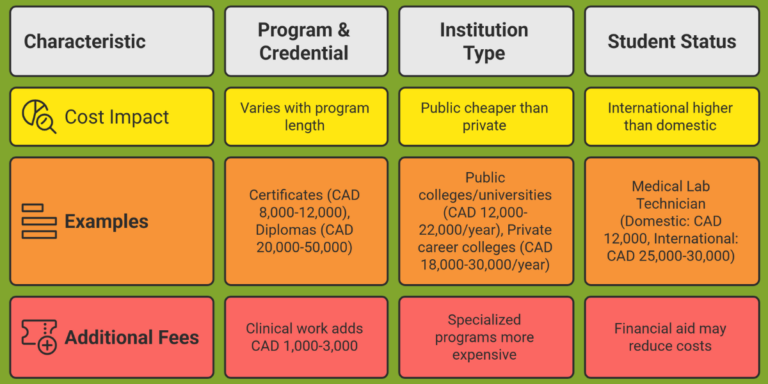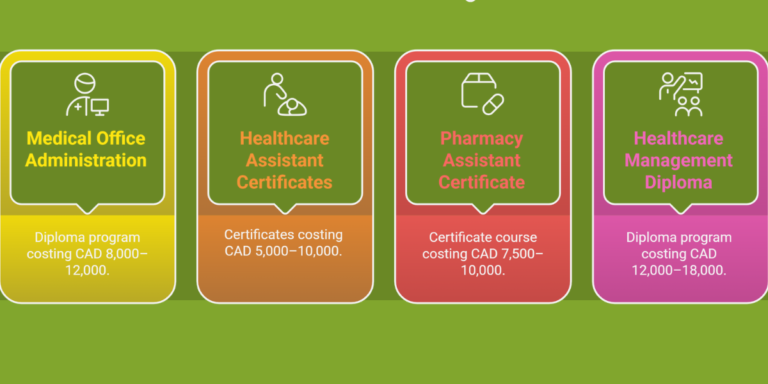Canada holds a strong reputation for its healthcare education and medical health programs. Each year, students arrive from around the globe, drawn by the country’s high academic standards, strong clinical training, and career opportunities in the health sector. With rising demand for professionals in nursing, pharmacy, lab technology, and personal care, healthcare training in Canada continues to expand.
When choosing from the many healthcare courses in Canada, students, parents, and advisors often ask: What does it actually cost to study these programs? This guide breaks down everything—from tuition fees and textbooks to housing and program comparisons. Whether you’re considering online healthcare programs, certifications, or full-time diplomas, knowing the complete cost helps with planning and decision-making.
Key Factors That Influence Medical and Health Care Program Costs

When considering the cost of medical courses in Canada, several factors contribute to the significant price differences between programs. Tuition and other expenses can change depending on where, what, and how you study.
Type of Program and Credential
The kind of credential has a big impact on cost. Short-term certificate programs are quicker and less expensive to complete than longer diploma or degree options. Here’s a breakdown of average program costs by credential type:
- Medical Assistant Course / Pharmacy Assistant Certificate Course (under 1 year): CAD 8,000 – 12,000 total
- Diploma in Practical Nursing (2 years): CAD 20,000 – 50,000 total
- Diagnostic Medical Sonography Diploma Program (2 years): CAD 25,000 – 50,000 total
- Physiotherapist Assistant & Occupational Therapist Assistant Diploma: CAD 12,000 – 22,000
- Diploma in Healthcare Management: CAD 15,000 – 25,000
Programs like Physiotherapist Assistant & Occupational Therapist Assistant, or a Diploma in Healthcare Management, often include clinical work, adding CAD 1,000 – 3,000 in lab and practicum fees to the total expense.
Note: Tuition estimates listed here can differ based on delivery mode, program updates, and local policies. Always verify with your chosen institution.
Type of Institution (Public vs. Private)
Where you study matters. Public colleges and universities usually have lower tuition rates than private career schools. Here is a breakdown of average tuition costs by institution type:
- Public Colleges/Universities: CAD 12,000 – 22,000 per year
- Private Career Colleges: CAD 18,000 – 30,000 per year
- Specialized Private Programs (e.g., Medical Esthetics, Acupuncture): CAD 25,000 – 40,000 total program cost
Private institutions may offer fast-track or niche programs like Medical Esthetics Diploma Programs or Acupuncture Diploma Training Programs, which tend to be more expensive due to specialized training and shorter durations.
Note: Public and private college fees are influenced by program format and funding structures. Check institutional websites for current rates.
Domestic vs. International Student Tuition
One of the biggest pricing differences lies between domestic and international students. International students often pay one and a half to three times more than Canadian citizens or residents. Here is a breakdown of sample tuition costs by student type:
Medical Laboratory Technician Training Program
- Domestic: CAD 12,000
- International: CAD 25,000–30,000
Registered Massage Therapist Program
- Domestic: CAD 15,000–20,000
- International: CAD 25,000–35,000
Pharmacy Technician Diploma
- Domestic: CAD 15,000–18,000
- International: CAD 25,000–32,000
Some institutions offer financial support, scholarships, or tailored entry pathways to help ease the cost for international learners.
Note: International tuition policies are subject to frequent changes. For precise figures, consult the admissions department of each school.
Average Tuition Costs for Medical and Health Care Diplomas & Certificates

Tuition costs can vary widely between programs. Here’s a breakdown of typical fees for some of the most sought-after health care courses in Canada.
General Cost Estimates
- Undergraduate diploma programs: CAD 15,000 to 36,000 per year
- Health Care Assistant certificate programs: Free in select provinces or up to CAD 9,518 annually
- Diploma in Practical Nursing: CAD 10,000 to 40,000 per year
- Pharmacy Technician Diploma: Around CAD 17,049 per year
- Medical Laboratory Technician Training Program: CAD 9,575 to 18,825 per year
Total costs over the course of study may range from CAD 20,000 to 80,000, depending on program length and institution.
Note: These costs serve as broad guidelines. Confirm current fees directly with your intended college or program advisor.
Other In-Demand Medical Diploma Programs
- Medical Assistant Course Cost: CAD 8,000 to 18,000 per year
- Physiotherapist Assistant & Occupational Therapist Assistant: CAD 12,000 to 22,000 per year
- Medical Office Administration Diploma Program: CAD 8,000 to 16,000 per year
- Diagnostic Cardiac Sonography Diploma Program: CAD 20,000 to 25,000 per year
- Diagnostic Medical Sonography Diploma Program: CAD 22,000 to 25,000 per year
- Acupuncture Diploma Training Program: CAD 15,000 to 20,000 per year
- Registered Massage Therapist Program: CAD 15,000 to 25,000 per year
- Personal Support Worker Program: CAD 8,000 to 12,000 per year
These medical diploma programs for international students often include additional registration, lab, and administrative fees ranging from CAD 500 to 2,000.
Note: Fees can vary from year to year and depend on your province and chosen college. Refer to official sources for accurate data.
Online and Hybrid Healthcare Programs: Are They Cheaper?

Online learning continues to gain popularity, offering increased flexibility and accessibility. For students considering online healthcare programs, affordability is another strong advantage.
Tuition Savings and Accessibility
Online healthcare programs often cost 10 to 30 percent less than traditional classroom-based programs. Here is a breakdown of typical savings:
- In-person Medical Office Administration Diploma Program: CAD 15,000
- Online version: CAD 10,000 – 12,000 → Savings: CAD 3,000 – 5,000
- Relocation and commuting costs saved: CAD 5,000 – 10,000 annually
- Total potential savings with online format: CAD 8,000 – 15,000 per year
For those balancing work or family, these programs are a practical way to lower healthcare costs in Canada.
Note: Online program pricing may vary by institution and access to resources. Please confirm with the program provider.
Popular Online Programs
Some well-regarded online offerings include:
- Medical Office Administration Diploma Program: CAD 8,000–12,000
- Healthcare assistant certificates: CAD 5,000–10,000
- Pharmacy Assistant Certificate Course: CAD 7,500–10,000
- Diploma in Healthcare Management Fees: CAD 12,000–18,000
These programs match the curriculum and value of in-person courses while reducing costs and improving accessibility.
Note: Tuition amounts listed reflect commonly available ranges and may not include all fees. Always confirm with the online program provider.
Connect with Us for Details on the Medical Health Care Courses and Diplomas in Canada
Textbooks, Supplies, and Additional Expenses

Education expenses don’t stop at tuition. Supplies, textbooks, and practicum fees add to the cost of training in health care.
Textbook Costs in Canada
Students usually spend between CAD 800 and 1,500 per year on textbooks. Here is a breakdown of typical textbook expenses:
- General textbooks for healthcare courses: CAD 100 – 200 each
- Specialized texts for medical programs (e.g., sonography, esthetics): CAD 250 – 300 each
- Annual textbook budget: CAD 800 – 1,500
- Savings options: Used books, rental programs, or e-book versions
Courses like the Diagnostic Medical Sonography Diploma Program or the Medical Esthetics Diploma Program often require multiple specialized texts, which can increase the annual textbook budget significantly.
Note: Textbook prices are approximate and may vary by course edition and format. Check your course syllabus or college bookstore.
Equipment and Clinical Supplies
Programs such as the Medical Laboratory Technician Training Program or the Registered Massage Therapist Program often require tools like stethoscopes, scrubs, lab kits, and personal equipment. Here’s a breakdown of typical equipment and supply costs:
- Stethoscope: CAD 80 – 150
- Lab coat/scrubs: CAD 60 – 120
- Medical/lab kits: CAD 100 – 250
- Software or simulation tools (if applicable): CAD 50 – 200
- Total estimated equipment cost per student: CAD 300 – 600
Some institutions include these items in tuition fees, while others require separate purchases by the student.
Note: Equipment costs vary based on program type and institutional requirements. Always request a materials list for up-to-date pricing.
Licensing and Practicum Fees
Many programs include unpaid clinical placements. These provide valuable experience but require students to plan for expenses while not earning income. Here’s a breakdown of typical practicum and licensing costs:
- Living expenses during unpaid practicum: CAD 2,000 – 5,000 (depending on duration and location)
- Certification exam fees: CAD 300 – 1,000 (varies by profession)
- Travel to practicum sites (if off-campus): CAD 100 – 500
- Uniforms or additional insurance (if required): CAD 50 – 200
These should all be considered as part of the total healthcare certification cost in Canada.
Note: Licensing and practicum-related costs depend on program structure and location. Consult your school for exact figures.
Living Expenses While Studying in Canada

Living costs are a major consideration for students planning to attend medical health programs. From rent to transit, expenses can vary by city and lifestyle.
Monthly Living Costs
Most students need between CAD 900 and 1,500 per month to cover housing, food, transportation, phone, and personal expenses. Here’s a breakdown of typical monthly living costs:
- Rent (Toronto/Vancouver): CAD 800 – 1,200
- Rent (Winnipeg/Halifax or smaller cities): CAD 500 – 900
- Food and groceries: CAD 300 – 500
- Transit pass: CAD 80 – 120
- Phone and internet: CAD 50 – 100
- Personal/miscellaneous expenses: CAD 100 – 300
These figures may vary depending on lifestyle, housing choice, and city, but they help estimate monthly budgeting for students in Canada.
Total Annual Cost (Tuition + Living)
- Domestic students: CAD 18,000 to 35,000 annually
- International students: CAD 25,000 to 60,000 annually
When exploring affordable medical courses in Canada, it’s important to calculate the full cost of attendance, not just tuition. Including supplies, books, and housing gives a more accurate budget.
Average Cost of University Courses and Medical School in Canada

University degrees and medical school programs involve a different level of investment. These options are ideal for students pursuing licensed professional paths.
University Courses
Health-related university courses usually cost between CAD 500 and 1,500 each. Here’s a breakdown of associated costs:
- Cost per course: CAD 500 – 1,500
- Full-time semester tuition: CAD 6,000 – 12,000
- Annual university tuition (two semesters): CAD 12,000 – 24,000
- Additional lab/clinical fees (if applicable): CAD 300 – 1,000 per course
Classes with labs or clinical training tend to be more expensive. These courses serve as building blocks for many careers in medical health programs.
Average Tuition for Medical School in Canada
- Domestic students: CAD 12,000 to 28,000 per year
- International students: CAD 25,000 to 70,000 per year
Over four to five years, total tuition costs range from CAD 60,000 to 150,000 for domestic students and CAD 120,000 to 300,000 for international students. Additional living and exam costs apply.
Cost Comparisons by Province

Program costs and living expenses vary across Canadian provinces. Regional comparisons can help students choose a location that fits their budget.
Ontario and BC
Ontario and British Columbia offer a broad range of medical diploma programs for international students. Here’s a breakdown of typical costs in these provinces:
- Tuition (per year): CAD 15,000 – 30,000
- Rent (shared accommodation): CAD 800 – 1,200/month
- Utilities and Internet: CAD 100 – 150/month
- Groceries and food: CAD 300 – 500/month
- Public transportation: CAD 100 – 150/month
- Total estimated living expenses: CAD 1,200 – 1,800/month or CAD 14,400 – 21,600/year
Higher demand and urban cost of living contribute to elevated tuition and expenses in cities like Toronto and Vancouver.
Alberta and the Prairies
In Alberta, programs like Health Care Assistant certificate training are sometimes subsidized. Here’s a breakdown of typical costs in Alberta and the Prairie provinces:
- Health Care Assistant Program Tuition: CAD 6,000 – 12,000 per year (may be subsidized)
- Rent (shared or student housing): CAD 500 – 900/month
- Utilities and Internet: CAD 80 – 120/month
- Groceries and food: CAD 250 – 400/month
- Transportation (public transit): CAD 70 – 110/month
- Total estimated living expenses: CAD 800 – 1,100/month or CAD 9,600 – 13,200/year
Lower rent and cost of living in the Prairie provinces help reduce the overall Canadian healthcare program’s tuition burden.
Quebec and Atlantic Provinces
Quebec offers low tuition, especially in French-language institutions. Here’s a breakdown of typical education and living costs in Quebec and the Atlantic provinces:
- Tuition (Quebec – domestic students): CAD 3,000 – 9,000/year
- Tuition (Quebec – international students): CAD 10,000 – 17,000/year
- Rent (shared or student housing): CAD 500 – 800/month
- Utilities and Internet: CAD 80 – 120/month
- Groceries and food: CAD 250 – 400/month
- Transportation: CAD 60 – 100/month
- Total estimated living expenses: CAD 900 – 1,200/month or CAD 10,800 – 14,400/year
- Total annual cost (including tuition): CAD 18,000 – 28,000/year
The Atlantic provinces, such as Nova Scotia and New Brunswick, offer similar programs and costs, making them attractive for budget-conscious students.
Scholarships, Government Support, and Financial Aid

Financial assistance makes education more accessible. Many students can reduce college healthcare fees in Canada through government or institutional support.
Canadian Financial Aid Options
Domestic students can apply for grants and loans through programs like OSAP, Alberta Student Aid, or StudentAid BC. Here’s a breakdown of typical financial support amounts:
- OSAP (Ontario): Up to CAD 12,000 – 15,000/year depending on need and program
- Alberta Student Aid: Up to CAD 10,000 – 13,300/year (loan and grant combined)
- StudentAid BC: CAD 7,000 – 12,000/year
- Eligible uses: Tuition, textbooks, and living expenses for programs like the Pharmacy Assistant Certificate Course and Medical Assistant Course
These funds often provide enough coverage for full tuition or a large portion of education-related costs.
Institutional Scholarships and Bursaries
Colleges often provide need-based and merit-based awards that help reduce education costs. Here’s a breakdown of typical scholarship amounts:
- General scholarship range: CAD 500 – 5,000 per year
- Medical Laboratory Technician Training Program scholarships: CAD 1,000 – 3,000
- Nursing program scholarships: CAD 1,500 – 4,000
- Pharmacy program scholarships: CAD 2,000 – 5,000
Students in high-demand fields like Medical Laboratory Technician Training Program, Nursing, or Pharmacy frequently qualify for additional funding, making these programs more accessible.
International Student Support
International students may qualify for entrance scholarships, bursaries, or work-study programs. Here’s a breakdown of common cost-saving opportunities:
- Entrance scholarships: CAD 1,000 – 5,000/year depending on merit and institution
- Bursaries (need-based): CAD 500 – 3,000/year
- Work-study program earnings: CAD 3,000 – 6,000/year
- Employer sponsorships or tuition reimbursement: CAD 2,000 – 10,000/year (based on agreements)
These supports can significantly reduce the financial burden of medical diploma programs for international students.
Are Healthcare Diplomas Worth the Investment?

Healthcare diplomas in Canada offer excellent value for students looking to quickly enter a growing industry. These programs tend to be shorter and more affordable than full university degrees, yet they lead to strong job prospects and competitive salaries. Here’s a closer look at what makes them a worthwhile investment:
Job Placement Rates
Many diploma programs report employment rates of 80% or higher within 6 months of graduation. Fields such as Personal Support Work, Pharmacy Assistance, and Medical Lab Technology have steady demand across provinces.
Entry-Level Salary Ranges
Graduates of healthcare diploma programs can expect to earn between CAD 35,000 and CAD 55,000+ annually in their first job. For example:
- Medical Office Administrators: CAD 38,000 – 48,000
- Pharmacy Technicians: CAD 42,000 – 55,000
- Diagnostic Medical Sonographers: CAD 55,000 – 75,000
- Personal Support Workers: CAD 35,000 – 45,000
- Physiotherapist & Occupational Therapist Assistants: CAD 38,000 – 52,000
- Medical Laboratory Technicians: CAD 40,000 – 55,000
- Medical Assistants: CAD 36,000 – 48,000
- Registered Massage Therapists: CAD 45,000 – 60,000
- Acupuncture Practitioners: CAD 45,000 – 65,000
- Healthcare Management Assistants: CAD 50,000 – 70,000
Permanent Residency Opportunities
For international students, many programs qualify for post-graduation work permits (PGWP), helping students accumulate Canadian work experience. This can lead to permanent residency under programs like the Canadian Experience Class (CEC) or Provincial Nominee Programs (PNP).
Note: Salary ranges and job outcomes depend on location, employer demand, and specific program credentials. Check with program advisors or job boards for current opportunities.
Choosing the Right Program Based on Budget and Goals

Careful planning enables students to select programs that align with both their career and financial goals. It’s essential to consider both the long-term benefits and the initial costs.
Cost vs. Career Outcome
Programs like the Diagnostic Cardiac Sonography Diploma Program, Acupuncture Diploma Training Program, or Pharmacy Assistant Certificate Course require a larger financial investment but often lead to higher earnings and job stability. Graduates can expect entry-level salaries ranging from CAD 45,000 to 75,000 annually, depending on role and location.
Permanent Residency and Work Pathways
Many medical diploma programs for international students qualify for work permits and contribute toward permanent residency eligibility. These added benefits make certain programs more appealing despite higher tuition. Estimated costs may be recovered through full-time employment within 2–3 years post-graduation.
Parent, Advisor, and Professional Considerations
Parents and advisors can help students evaluate all costs, not just tuition. Planning tools, financial aid resources, and clear career goals make a difference when selecting from health care courses in Canada. A detailed budget spreadsheet is helpful for comparing schools, fees, supplies, and housing across multiple programs.
Why Choose Pharma-medical Science College of Canada for Your Healthcare Education?

Pharma-Medical Science College of Canada offers comprehensive medical health programs with a focus on hands-on learning and industry-relevant skills. Programs meet the needs of the healthcare, pharmaceutical, and food sectors.
Our tuition is competitive, and many students qualify for assistance through OSAP, Second Career, and ODSP. These supports help us offer accessible healthcare education to a diverse student population.
We welcome learners from around the world and offer comprehensive support for medical diploma programs for international students. Our staff helps students navigate study permits, job training, and career placement.
Graduates from our college find employment across the healthcare and pharmaceutical fields. With expert instructors and practical labs, students gain the skills needed for immediate workforce entry. Many of our graduates secure employment within 3–6 months of completing their training.
Conclusion
The cost of medical courses in Canada varies based on program type, location, and student status. From certifications to full medical degrees, options exist for a wide range of goals and budgets.
By reviewing tuition, living expenses, and available aid, students can find affordable medical courses in Canada that support long-term success. Take time to research programs, connect with admissions advisors, and apply early to secure financial support and maximize career opportunities.
Start your healthcare journey with confidence at Pharma-medical Science College of Canada. Apply today and take advantage of our affordable, career-focused programs designed for local and international students.
Summary: Please note that the cost figures throughout this article are approximate and intended to serve as general guidelines. Actual fees may differ based on program duration, location, institution, and delivery method. Always check directly with the program provider for the most current and accurate information.






